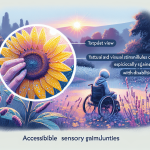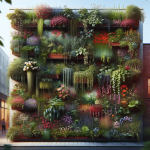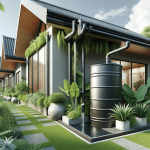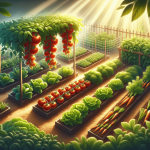This post may contain affiliate links. As an Amazon Associate, we may earn commissions from qualifying purchases.
Ever find yourself wondering how you can contribute to cooling down your urban surroundings with something as simple and beautiful as a garden? With growing concerns about climate change and urbanization, the heat island effect is a common problem. Cities full of concrete and asphalt absorb and retain heat, making them hotter than their rural counterparts. However, designing a garden with key principles in mind can help mitigate this issue. Let’s look into how you can effectively create a garden to reduce the heat island effect in urban areas.
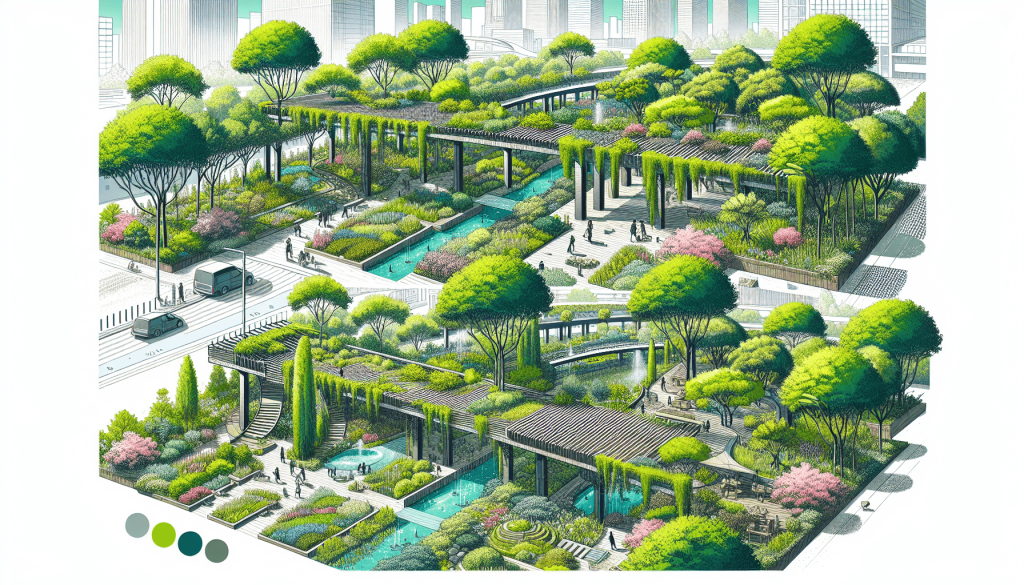
Understanding Urban Heat Island Effect
First things first, what exactly is this “urban heat island effect” we’re talking about? Essentially, it’s a phenomenon where urban areas become significantly warmer than their rural surroundings. This happens due to human activities and the abundance of heat-absorbing surfaces like asphalt, concrete, and buildings. Can you feel the difference when you walk from a city park into the heart of downtown? Well, that’s the heat island effect in action.
Factors Influencing Urban Heat Islands
Let’s pinpoint what actually contributes to this temperature rise:
| Factor | Description |
|---|---|
| Materials | Concrete, asphalt, and metal absorb and retain heat. |
| Lack of Vegetation | Fewer plants mean less natural cooling through transpiration. |
| Building Density | Closely packed buildings trap heat. |
| Human Activities | Cars, air conditioners, and industrial processes generate heat. |
With these culprits identified, it becomes clearer how a garden can counteract some of these factors.
Benefits of a Well-Designed Garden
So, you might ask, “Why bother designing a garden specifically to combat the heat island effect?” There are numerous benefits that go beyond just a cooler environment:
- Improved Air Quality: Plants absorb pollutants and release oxygen.
- Enhanced Appearance: A lovingly designed garden can transform a drab urban area into a visual delight.
- Psychological Well-being: There’s something inherently soothing about greenery, affecting mood and mental health positively.
- Biodiversity Boost: Think of the bees and butterflies that could make your garden a new home.
- Water Management: Gardens can help manage stormwater runoff, reducing the risk of floods.
Elements of a Heat-Reducing Garden
If you’re ready to roll up your sleeves and get gardening, it’s crucial to consider specific elements that can make your urban garden effective in reducing heat.
Use Native and Drought-Resistant Plants
Native plants are well-adapted to your local climate and soil conditions, making them more efficient in water use and generally easier to maintain. Drought-resistant plants, like succulents and specific grasses, require less water and thrive even in high temperatures.
Incorporate Trees for Shade
Trees are like nature’s air conditioners. By providing shade, they not only cool the air but also reduce the heat absorbed by buildings and paved surfaces. Trees with broad canopies, like oaks and maples, are particularly effective.
Create Green Roofs and Walls
If ground space is limited, think vertically. Green roofs and walls can be as effective as ground-level gardens when it comes to cooling. They insulate buildings, reducing the amount of energy needed for air conditioning.
Use Reflective or Light-Colored Materials
Dark surfaces absorb more heat. By using light-colored or reflective materials for pathways and garden features, you can decrease the overall temperature. Think white gravel, light pavers, or even specially designed “cool pavement” materials.
Water Features
A well-placed fountain or pond can also help reduce surrounding temperatures through the process of evaporative cooling. Besides, the soothing sound of trickling water can turn your garden into a calming oasis amidst the urban chaos.
Practical Steps to Start Your Garden
You’re probably thinking, “Great, but how do I actually get started?” You don’t need a degree in horticulture to create an effective garden. Here are some practical steps to kick things off.
Assess Your Space
Look around to see how much space you can dedicate to your garden. Whether it’s a small balcony, a rooftop, or a sprawling backyard, the steps remain quite similar. Also, observe the sunlight and shade pattern throughout the day.
Soil Preparation
Healthy plants need healthy soil. Test your soil’s pH levels and nutrient content. Add compost or other organic matter to improve soil quality if needed. Raised beds can be a great option if your soil is particularly poor or contaminated.
Choose Your Plants
Select a mix of native and drought-resistant plants. Group plants with similar water and sunlight needs to make maintenance easier. If trees are part of your plan, remember to consider their mature size and root systems to avoid future challenges.
Plan Your Layout
Think about the placement of taller plants and trees to maximize shade. Arrange plants to allow for good airflow, which helps in cooling. Include pathways to move around easily and perhaps a seating area to enjoy your new green space.
Install Irrigation
Watering can become quite a chore, so consider installing an efficient irrigation system like drip irrigation. This method conserves water and ensures that your plants get the hydration they need without wasting resources.
Add Mulch
Mulch not only helps retain soil moisture but also keeps the ground cooler. Organic mulch options like wood chips or straw work well and eventually break down to enrich the soil.
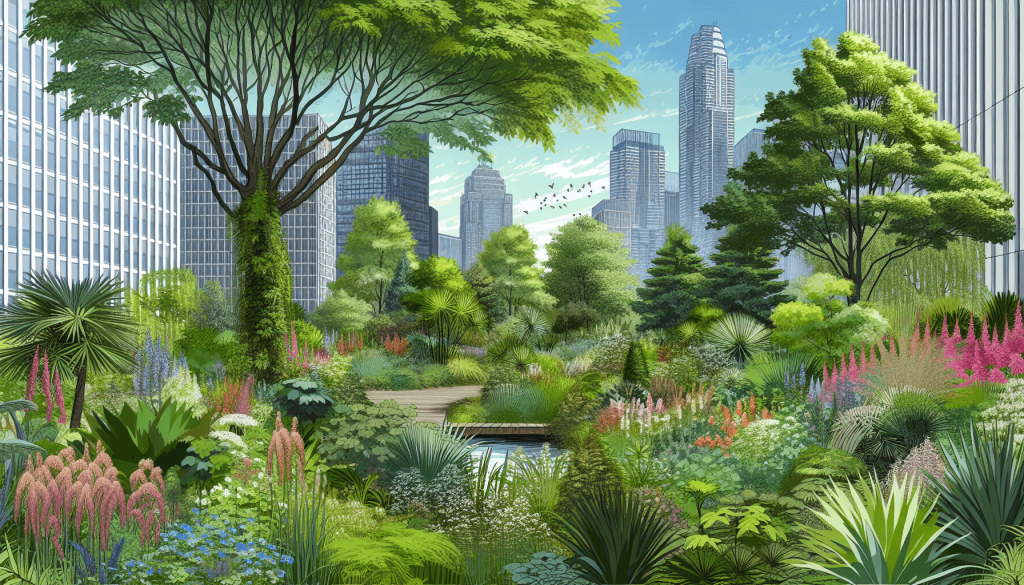
Maintenance Tips for Your Heat-Reducing Garden
Once your garden is up and running, regular care is essential to ensure it continues to thrive and achieve its heat-reducing goals.
Watering
Regular watering is crucial, especially in the initial stages when plants are becoming established. Opt for watering early in the morning or late in the evening to minimize evaporation.
Pruning and Trimming
Keeping your plants healthy and well-maintained helps them grow better. Regular pruning of dead or overgrown branches ensures that plants remain well-ventilated.
Pest Management
Urban gardens can attract pests, but chemical pesticides should be a last resort. Consider natural methods like introducing beneficial insects or using organic repellents.
Seasonal Care
Your garden will have different needs as the seasons change. Mulch heavily in the winter to protect roots and make sure to adjust your watering schedule according to seasonal rainfall.
Regular Monitoring
Make it a habit to walk through your garden regularly. Check for signs of disease, stress, or water issues. The more attentive you are, the better you can address problems before they escalate.
Community Involvement
If you find that your efforts are paying off, why not take it a step further? Encouraging your neighbors or local community to join in can amplify the benefits. A collective effort can lead to larger green spaces, increasing the overall impact on reducing the urban heat island effect.
Organize Workshops
Share your newfound knowledge with others by organizing workshops or gardening sessions. Teaching others the benefits and techniques of heat-reducing gardens can lead to wider community adoption.
Community Gardens
If your space is limited, consider advocating for a community garden in your neighborhood. These not only provide shared green spaces but also foster community spirit and team effort.
Collaborate with Local Authorities
Local councils and urban planners might have resources or grants available for green projects. Collaborating with them can provide additional support, guidance, and funding for larger scale gardening efforts.
Real-Life Examples
Need a little inspiration? There are several cities around the world that have successfully implemented gardens to reduce the urban heat island effect. Let’s look at a few:
New York City, USA
New York has taken significant steps to combat urban heat by promoting green roofs and urban tree planting campaigns. The “MillionTreesNYC” initiative aims to plant one million new trees across the city’s five boroughs.
Melbourne, Australia
Melbourne’s Urban Forest Strategy aims to increase the city’s tree canopy cover from 22% to 40% by 2040. This ambitious project combines tree planting with community education and involvement.
Tokyo, Japan
Tokyo has embraced green rooftops, with regulations in place requiring new large buildings to dedicate a percentage of their rooftop space to greenery. This initiative helps mitigate heat while providing much-needed green spaces in the dense urban environment.
Conclusion
In the grand scheme of things, a garden might seem like a small contribution to a colossal problem. Yet, by designing a garden that effectively reduces the urban heat island effect, you’re not only making your immediate surroundings more pleasant but also contributing to a cooler, more livable city. Whether it’s through selecting the right plants, creating shade, or even promoting these ideas within your community, your efforts can indeed make a significant difference. Now, isn’t that a lovely way to give back to your environment while enjoying the benefits of a thriving, cooling green space? So go ahead—grab those gardening gloves and make your urban area a bit kinder, greener, and cooler.


